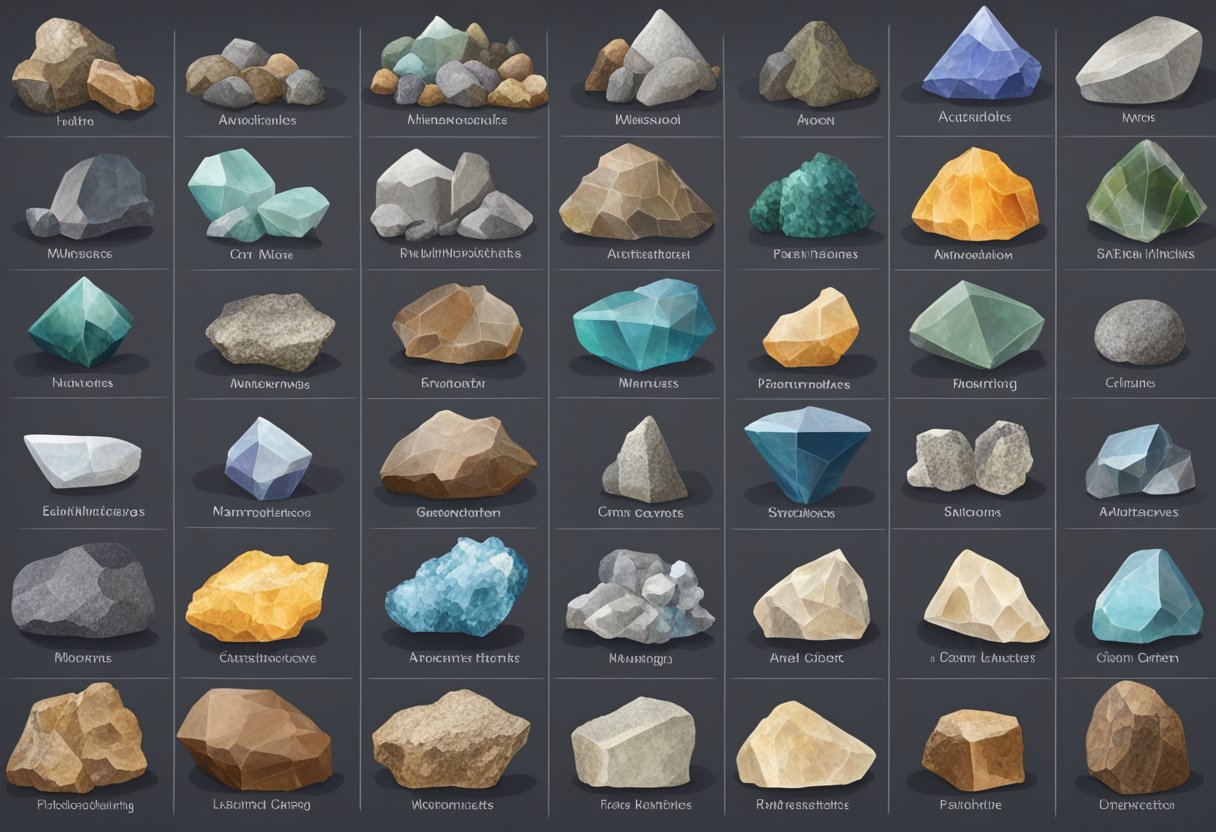Types Of Minerals
Minerals are naturally occurring substances that are essential to our daily lives. They are used in various industries, including construction, electronics, and medicine. Minerals are classified based on their chemical composition and physical properties. There are over 4,000 known minerals, each with unique properties and uses.
Minerals are classified into two main categories: metallic and non-metallic. Metallic minerals are those that contain metal elements, such as iron, copper, and gold. Non-metallic minerals, on the other hand, do not contain metal elements and are used for their physical properties, such as their hardness, color, and luster. Some examples of non-metallic minerals include quartz, mica, and calcite.
Understanding the physical and chemical properties of minerals is essential for their identification and use. Minerals have distinct physical properties, such as their crystal structure, hardness, and cleavage. Their chemical composition also plays a vital role in their properties and uses. For example, the mineral halite, or table salt, is used in the food industry because of its chemical composition and unique physical properties.
Key Takeaways
- Minerals are naturally occurring substances that are classified based on their chemical composition and physical properties.
- Metallic and non-metallic minerals are the two main categories of minerals.
- Understanding the physical and chemical properties of minerals is essential for their identification and use.
Classification of Minerals

Minerals are classified based on their chemical composition. The International Mineralogical Association (IMA) has classified minerals into various groups based on their anionic group. The following are the different types of minerals:
Silicate Minerals
Silicate minerals are the most abundant minerals on Earth. They are composed of silicon and oxygen, and they form the basic building blocks of rocks. Silicate minerals are further divided into various groups based on their chemical composition. Some of the common groups are sheet silicates, chain silicates, and framework silicates.
Carbonates
Carbonates are minerals that contain the carbonate anionic group (CO3)2-. Some of the common carbonate minerals are calcite, dolomite, and aragonite. Carbonate minerals are important sources of calcium, magnesium, and other elements.
Oxides
Oxides are minerals that contain the oxide anionic group (O2-). Some of the common oxide minerals are hematite, magnetite, and corundum. Oxide minerals are important sources of iron, aluminum, and other elements.
Sulfides
Sulfides are minerals that contain the sulfide anionic group (S2-). Some of the common sulfide minerals are pyrite, galena, and sphalerite. Sulfide minerals are important sources of copper, lead, zinc, and other elements.
Halides
Halides are minerals that contain the halide anionic group (Cl-, F-, Br-, or I-). Some of the common halide minerals are halite, fluorite, and sylvite. Halide minerals are important sources of chlorine, fluorine, and other elements.
Native Elements
Native elements are minerals that are composed of only one element. Some of the common native elements are gold, silver, and copper. Native element minerals are important sources of precious metals.
In conclusion, minerals are classified based on their chemical composition. The different types of minerals are silicate minerals, carbonates, oxides, sulfides, halides, and native elements. Each group of minerals has its unique properties and uses.
Physical and Chemical Properties
Minerals have unique physical and chemical properties that help in their identification and classification. Understanding these properties is essential in mineralogy, geology, and related fields. In this section, we will discuss some of the most important physical and chemical properties of minerals.
Color and Streak
Color is one of the most noticeable physical properties of minerals. It is usually the first characteristic that is used to identify a mineral. However, some minerals can have different colors, making it difficult to use color alone for identification. Streak, on the other hand, is the color of the powdered mineral. It is a more reliable property because most minerals have a consistent streak color. To determine the streak, one can rub the mineral on a piece of unglazed porcelain called a streak plate.
Hardness and Cleavage
The hardness of a mineral is its resistance to scratching. It is measured using the Mohs scale, which ranges from 1 (softest) to 10 (hardest). For example, talc has a hardness of 1, while diamond has a hardness of 10. Cleavage is the tendency of a mineral to break along certain planes of weakness. Some minerals have perfect cleavage, meaning they break into smooth, flat surfaces, while others have poor cleavage and break into irregular fragments.
Crystal Structure and Specific Gravity
The crystal structure of a mineral refers to the arrangement of atoms in its crystal lattice. It is determined by X-ray diffraction analysis. The specific gravity of a mineral is its density relative to the density of water. It is a useful property for identifying minerals because different minerals have different specific gravities.
Luster and Transparency
Luster refers to the way a mineral reflects light. It can be metallic, non-metallic, or earthy. Transparency refers to how much light can pass through a mineral. Minerals can be transparent, translucent, or opaque. These properties are useful for identifying minerals and can provide clues about their chemical composition.
In summary, physical and chemical properties are important characteristics of minerals that help in their identification and classification. Color, streak, hardness, cleavage, crystal structure, specific gravity, luster, and transparency are some of the most important properties to consider when identifying minerals.
Economic and Industrial Minerals
Precious Metals and Gemstones
Precious metals and gemstones are some of the most valuable minerals on earth. They are highly sought after for their rarity and beauty. The most well-known precious metals are gold, silver, and platinum. These metals are used in jewelry, currency, and electronics. Gemstones, on the other hand, are prized for their beauty and are used in jewelry and decorative objects. Some of the most popular gemstones include diamonds, emeralds, and rubies.
Gold is one of the most valuable metals in the world. It is used in jewelry, electronics, and currency. Gold is also used as a hedge against inflation and economic instability. Silver, another precious metal, is used in jewelry, electronics, and silverware. Platinum is a rare and valuable metal that is used in jewelry, catalytic converters, and electronics.
Gemstones, like precious metals, are highly valued for their beauty. Diamonds are the most popular gemstone and are used in engagement rings and other jewelry. Emeralds, rubies, and sapphires are also popular gemstones that are used in jewelry and decorative objects.
Industrial Minerals
Industrial minerals are non-metallic minerals that are used in various industries. They are often used as raw materials in the production of other goods. Some common industrial minerals include copper, aluminum, iron, and manganese.
Quartz and feldspar are two industrial minerals that are used in the production of glass and ceramics. Calcite is another industrial mineral that is used in the production of cement and building materials.
Industrial minerals are also used in the production of electronics, batteries, and other high-tech products. For example, lithium is an industrial mineral that is used in the production of batteries for electric cars and other electronic devices.
In conclusion, precious metals and gemstones are highly valued for their rarity and beauty, while industrial minerals are essential raw materials used in the production of a wide range of goods.
Mineral Formation and Occurrence
Minerals are naturally occurring inorganic substances that are formed through various geological processes. The formation of minerals can occur through igneous, sedimentary, or metamorphic processes. Each process results in different types of minerals with unique properties.
Igneous Processes
Igneous processes involve the cooling and solidification of molten rock, known as magma. As the magma cools, rock-forming minerals crystallize and form an igneous rock. The minerals that form depend on the composition of the magma. For example, a magma rich in silica will form minerals such as quartz and feldspar, which are silicates.
Sedimentary Processes
Sedimentary processes involve the accumulation of sediment over time. The sediment can be made up of particles of other rocks that have undergone weathering or erosion. As the sediment is deposited, it undergoes compaction and cementation, forming sedimentary rocks. The minerals that form in sedimentary rocks are often carbonates, such as calcite and dolomite.
Metamorphic Processes
Metamorphic processes involve the transformation of pre-existing rocks due to heat and pressure. The minerals that form during metamorphism depend on the original composition of the rock and the conditions under which it was metamorphosed. For example, the mineral garnet forms in metamorphic rocks that have undergone high pressure and temperature.
Overall, the formation of minerals is a complex process that is influenced by various factors, including the composition of the original material, temperature, pressure, and time. By understanding the processes that lead to mineral formation, geologists can better understand the history of the Earth and the resources it provides.
Mineral Identification and Analysis
Field Identification
Mineral identification is a crucial step in mineral exploration and mining. It involves determining the physical and chemical properties of a mineral to classify it. Mineralogists are experts in identifying minerals and their properties. They use various techniques to identify minerals in the field.
One of the most common techniques used in field identification is observing the physical properties of a mineral. Physical properties such as color, luster, hardness, cleavage, and fracture are useful in identifying minerals. For example, the color of a mineral can give clues about its chemical composition. Luster refers to the way a mineral reflects light, and it can be metallic or non-metallic. Hardness is the resistance of a mineral to scratching, and it can be determined using the Mohs scale. Cleavage is the way a mineral breaks along flat surfaces, while fracture is the way it breaks along irregular surfaces.
Another technique used in field identification is observing the crystal structure of a mineral. The crystal structure of a mineral is the arrangement of atoms in the mineral. The International Mineralogical Association has identified over 5,000 mineral species, each with a unique crystal structure.
Laboratory Techniques
Laboratory techniques are also used in mineral identification and analysis. These techniques involve more advanced equipment and procedures than field identification.
One laboratory technique used in mineral identification is X-ray diffraction (XRD). XRD is used to determine the crystal structure of a mineral. It works by passing X-rays through a mineral sample and measuring how the X-rays are diffracted. This information is used to determine the crystal structure of the mineral.
Another laboratory technique used in mineral identification is electron microscopy. Electron microscopy is used to observe the physical and chemical properties of a mineral at a microscopic level. It can reveal details about the crystal structure, composition, and texture of a mineral.
In conclusion, mineral identification and analysis is a crucial step in mineral exploration and mining. Mineralogists use various techniques to identify minerals based on their physical and chemical properties. Field identification techniques involve observing the physical properties and crystal structure of a mineral, while laboratory techniques involve more advanced equipment and procedures such as X-ray diffraction and electron microscopy.






